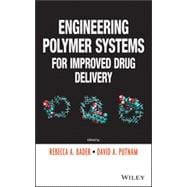Polymers have played a critical role in the rational design and application of drug delivery systems that increase the efficacy and reduce the toxicity of new and conventional therapeutics. Beginning with an introduction to the fundamentals of drug delivery, Engineering Polymer Systems for Improved Drug Delivery explores traditional drug delivery techniques as well as emerging advanced drug delivery techniques. By reviewing many types of polymeric drug delivery systems, and including key points, worked examples and homework problems, this book will serve as a guide to for specialists and non-specialists as well as a graduate level text for drug delivery courses.








